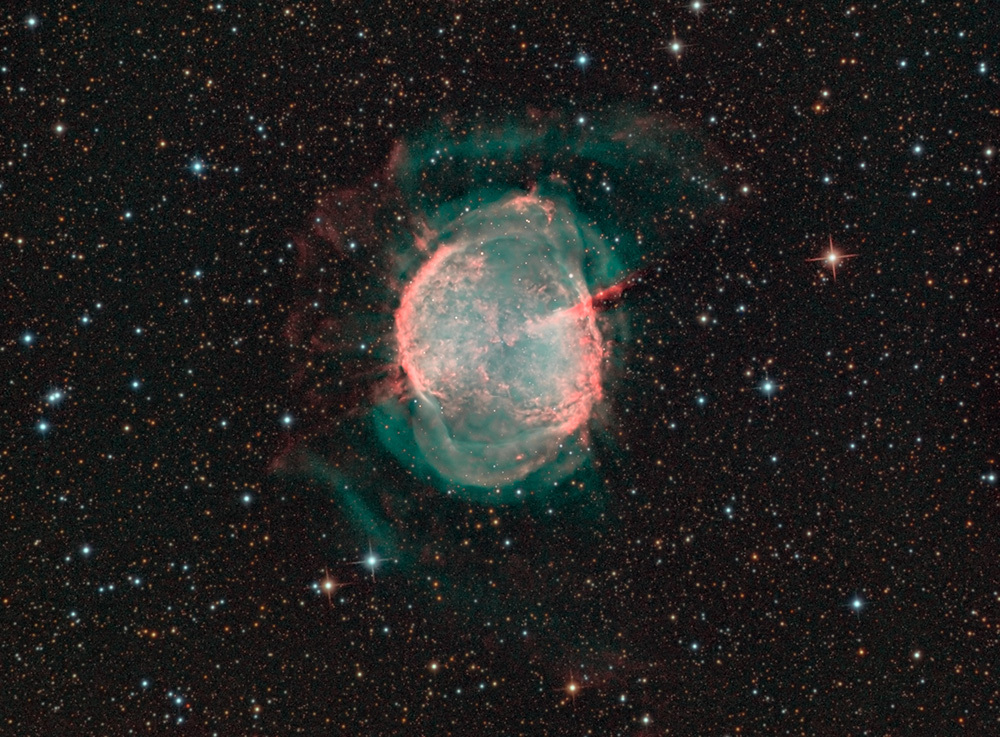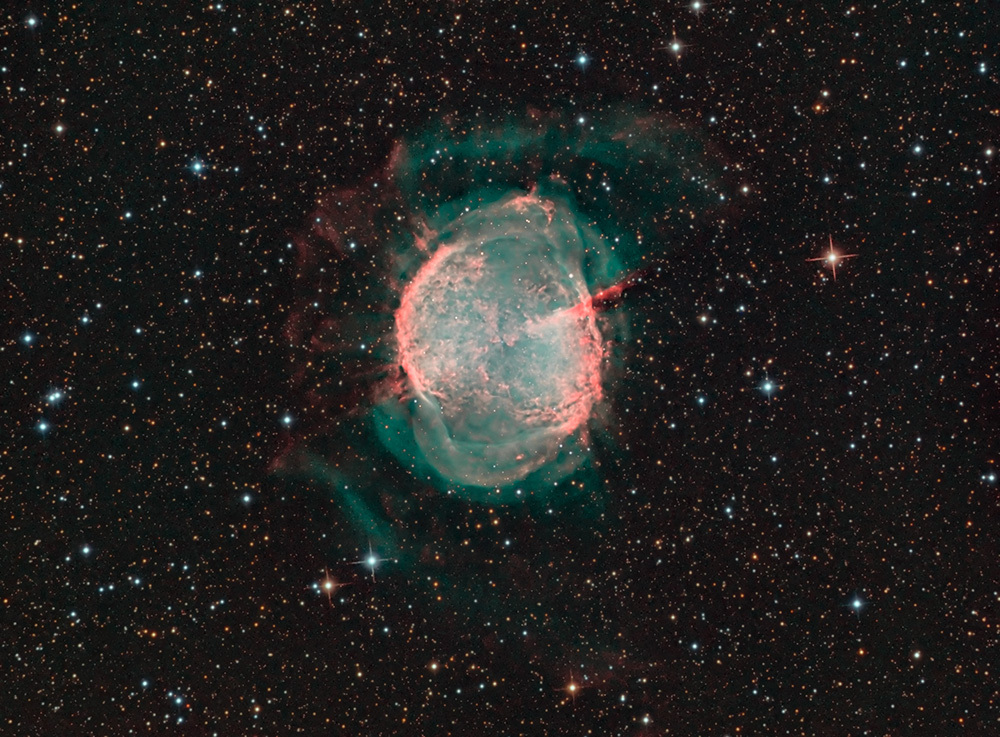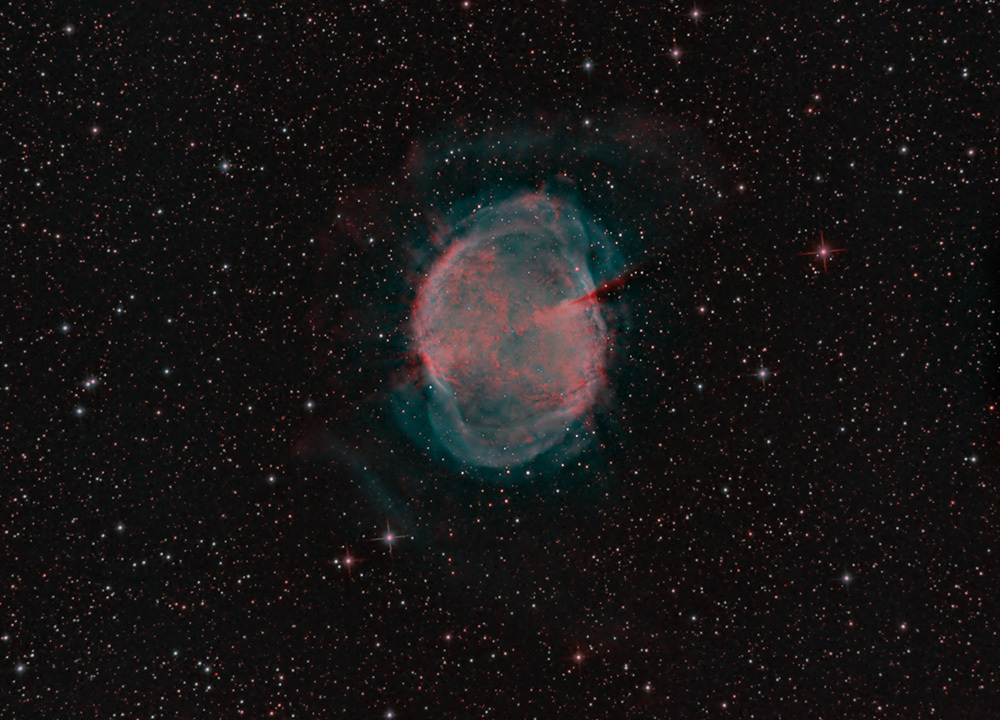27 hours of unattended SGP exposure - mind you, I did 50 Luminances which I didn’t really need in the end.
L Ha OIII R G B - RC10.
The interior detail is stunning… nice work.
Really impressive detail, and you sure picked up more outlying tendrils of gases than most images that I see of M27. Well done!
Can you give us some details about camera, sub length, etc?
Dean
HI - I am about 30 miles from London, so the skies are not that dark. For this I had a 10" f/8 GSO RCT, with a QSI683, fitted with Astrodon filters. I use a 5nm Ha and a 3nm O3. I had 25 subs of 20 mins for the narrowband. I also took extensive LRGB but when I processed this in PixInsight, using the SHO-AIP script - they did not really figure much in the blend. In fact, I really just used the LRGB to make the star color natural. The Ha was assigned to red and the O3 was blended across G and B.
I discovered that my extensive luminance did not pick out the details very well, so I separately processed the NB, with masked stretch, local histogram equalization and a bit of multiscale median transform to bring out the detail. Only then did I combine them. I learned a lot and it will be a written up as a practical assignment in the next book.
On screen here, the background looks a bit noisy - but not on my original file, I will have to take a look at that.
Chris Woodhouse
Really nice Chris.
Thanks for posting.
Mark
Great image Chris, especially the interior details and structure that you’ve teased out of the data. I look forward to seeing a version without the ‘noise’ in this uploaded one.
Yes, that’s better. Top drawer Chris - terrific.
Nice job buzz. That’s pretty fantastic.
What is the ‘noise’ you have in the picture from? Is that due to some type of noise reduction technique?
The top image just had MURE on the narrowband images. The second one had TGVDenoise and MMT. I don’t like the plastic look and since the subject is in the Milky Way and I was a little unsure if some were not stars! I have since realized that the red channel is almost clipped so re-traced my steps and gave some headroom on the stretching. I love PI projects!
Yea, it’s so much ‘fun’  It looks really deep. I wonder if you added more frames to it you’d see that pattern disappear. Did you dither?
It looks really deep. I wonder if you added more frames to it you’d see that pattern disappear. Did you dither?
not sure what you mean by pattern - you got me worried now… yes I dithered and did some cosmetic correction too during batchpreprocessing. I had a bit of a revelation during the processing but I don’t want to spoil the surprise 
I see a noise ‘pattern’. It reminds me of when I try to hard at noise reduction (because I’m terrible at it). Do you see how it repeats?
Btw, this is completely nitnoid… I love your data. It’s a really good picture.
There is nothing but random noise on the 16-bit full size Adobe 1998 TIFF file. It must be the downsizing and conversion to sRGB. I did play with it further and pulled out even more faint nebulosity in the periphery. If you are not careful, DBE can wipe out faint details.
Yea, do you use ABE? It’s a little better on nebula.
BUZZ!
So, I tried out MureDenoise on an image I took and guess what? I see the same noise pattern you have! I think you have to use something like TGVDenoise to remove the remaining noise to get it smooth.
Anyways, just wanted to point out I can do it too! 
I have seen pattern noise with MURE if you choose the wrong interpolation - I used TGV and MMT later on. I have all the steps backed up and I will take another swipe at it over the weekend.
Much better detail in this one - very crisp. I’m a novice with PI and all I can do is drool.
Looks great to me. The “noise” looks to be about layer 2 or 3 in a PI MMT. I used to like TGV but recently have found that MMT seems to work better on almost every nebula image but using 6 layers instead of the typical 4. I have taken to using a pretty high adaptive on the lower frequency layers and then adjusting adaptive on the layers one a a time starting from layer one. It isolates where the noise is coming from nicely.


